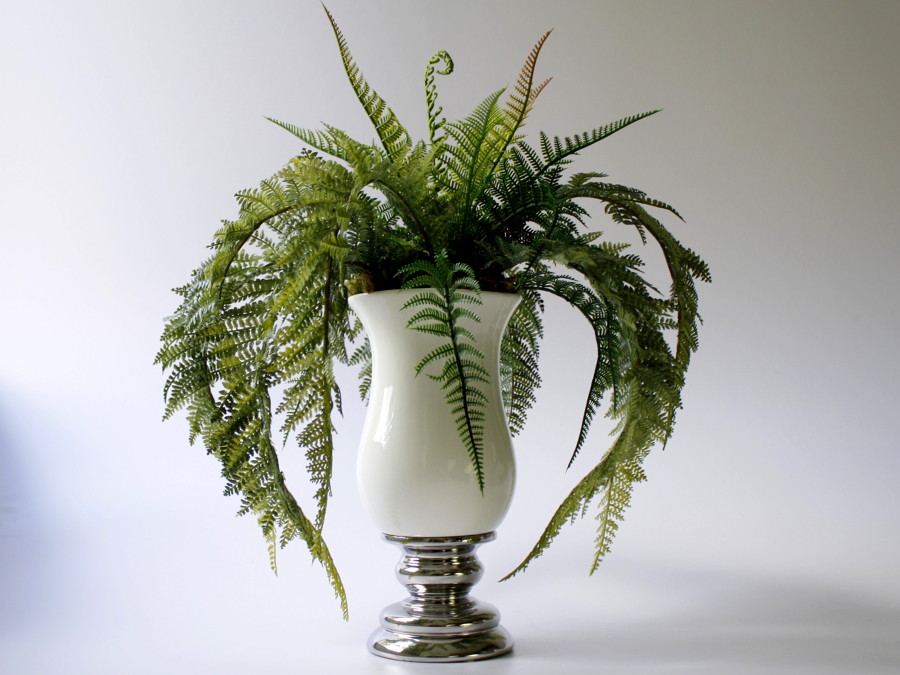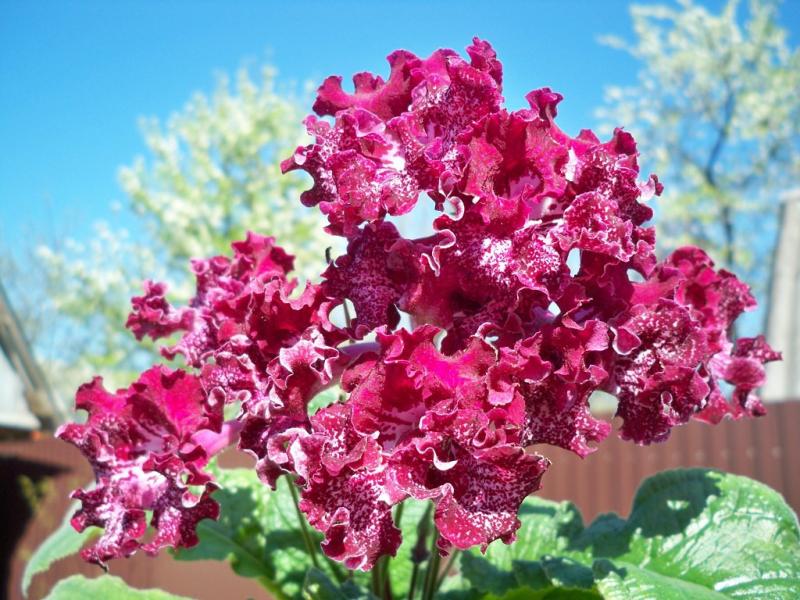Plants belonging to the vascular plant division are called ferns. They are an example of ancient flora, since their ancestors appeared on Earth 400 million years ago in the Devonian period. At that time they were of enormous size and reigned on the planet.
It has an easily recognizable look. Moreover, today there are about 10 thousand species and names of them. However, they can have very different sizes, structural features or life cycles.
Description of ferns
Because of their structure, ferns adapt well to the environment, they love moisture. Since they emit a large number of spores during reproduction, they grow almost everywhere. Where do they grow:
 In the forests where they feel great.
In the forests where they feel great.- In the swamp.
- In water.
- On the mountain slopes.
- In the deserts.
Summer residents and villagers often find it on their plots, where they fight with it like a weed. The forest species is interesting in that it grows not only on the ground, but also on the branches and trunks of trees. It is worth noting that this is a plant that can be both grass and shrubs.
This plant is interesting in that, if most of the other representatives of the flora reproduce by seeds, then its distribution occurs using spores that ripen on the lower part of the leaves.
The forest fern occupies a special place in Slavic mythology, since from ancient times there was a belief that on the night of Ivan Kupala it blooms for a moment.
Those who manage to pick a flower will be able to find a treasure, acquire the gift of clairvoyance, and learn the secrets of the world. But in reality the plant never bloomsbecause it reproduces in other ways.
Also, some species can be eaten. Other plants of this department, on the contrary, are poisonous. They can be seen as houseplants. Woods are used in some countries as a building material.
Ancient ferns served as a raw material in the formation of coal, becoming a participant in the carbon cycle on the planet.
What structure do plants have
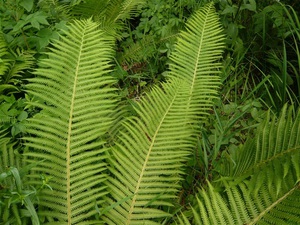 The fern has practically no root, which is a horizontally growing stem from which adventitious roots emerge. From the buds of the rhizome, leaves grow - fronds, which have a very complex structure.
The fern has practically no root, which is a horizontally growing stem from which adventitious roots emerge. From the buds of the rhizome, leaves grow - fronds, which have a very complex structure.
The frond cannot be called ordinary leaves; rather, it is their prototype, which is a system of branches attached to the petiole, located at the same level. In botany fronds are called flat-lined.
The fronds serve two important functions. They take part in the process of photosynthesis, and on their underside the maturation of spores occurs, with the help of which plants reproduce.
The supporting function is performed by the bark of the stems. Ferns have no cambium, so they low strength and there are no annual rings. Conductive tissue is not as developed as compared to seed plants.
It should be noted that the structure is highly dependent on the species. There are small herbaceous plants that can be lost against the background of other inhabitants of the earth, but there are also mighty fernsresembling trees.
Thus, plants from the Cyateaceae family that grow in the tropics can grow up to 20 meters. A rigid plexus of adventitious roots forms the trunk of a tree, preventing it from falling.
In aquatic plants, the rhizome can reach a length of 1 meter, and the above-water part will not exceed 20 centimeters in height.
Reproduction methods
 The most characteristic feature that sets this plant apart from others is reproduction. He can do this through spores, vegetatively and sexually.
The most characteristic feature that sets this plant apart from others is reproduction. He can do this through spores, vegetatively and sexually.
Reproduction takes place as follows. On the bottom of the sheet sporophylls develop... When spores hit the ground, they develop outgrowths, that is, bisexual gametophytes.
The outgrowths are plates no more than 1 centimeter in size, on the surface of which the genitals are located. After fertilization, a zygote is formed, from which a new plant grows.
Ferns usually have two life cycles: asexual, which is represented by sporophytes, and sexual, in which gametophytes develop. Most of the plants are sporophytes.
Sporophytes can reproduce vegetatively... If the leaves are on the ground, a new plant may develop on them.
Types and classification
Today, there are thousands of species, 300 genera and 8 subclasses. Three subclasses are considered extinct. Of the remaining fern plants, the following can be listed:
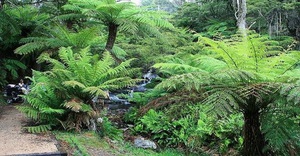 Marattievye.
Marattievye.- Uzhovnikovye.
- Real ferns.
- Marsiliaceae.
- Salviniaceae.
The ancients
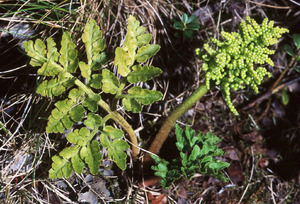 Uzhovnikovs are considered the most ancient and primitive. In their appearance, they differ markedly from their counterparts. So, the common snake has only one leaf, which is a solid plate, divided into sterile and spore-bearing parts.
Uzhovnikovs are considered the most ancient and primitive. In their appearance, they differ markedly from their counterparts. So, the common snake has only one leaf, which is a solid plate, divided into sterile and spore-bearing parts.
Supers are unique in that they have cambium rudiments and secondary conductive tissues. Since one or two leaves are formed per year, the age of the plant can be determined by the number of scars on the rhizome.
Accidentally found forest specimens may be several decades old, therefore, this small plant is no younger than the trees surrounding it. The sizes of the snakes are small, on average, their height is 20 centimeters.
Maratha ferns are also an ancient group of plants. Once they populated the entire planet, but now their number is constantly decreasing. Modern examples of this subclass can be found in rainforests. The fronds of the Marattiaceae grow in two rows and reach 6 meters in length.
Real ferns
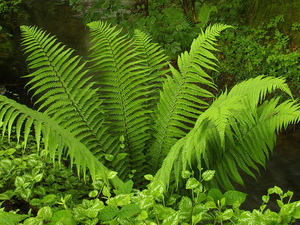 This is the most numerous subclass. They grow everywhere: in deserts, forests, in the tropics, on rocky slopes. The real ones can be both herbaceous plants and woody ones.
This is the most numerous subclass. They grow everywhere: in deserts, forests, in the tropics, on rocky slopes. The real ones can be both herbaceous plants and woody ones.
Of this class, the most common species from the family multi-track... In Russia, they most often grow in forests, preferring shade, although some representatives have adapted to life in illuminated places with a lack of moisture.
On rocky deposits, a beginner naturalist can find brittle bubble... It is a stunted plant with thin leaves. Very poisonous.
It grows in shady forests, spruce forests or along river banks common ostrich... It has clearly separated vegetative and spore-bearing leaves. The rhizome is used in folk medicine as an anthelmintic.
In deciduous and coniferous forests in moist soil grows male shieldworm... It has a poisonous rhizome, but the filmcin it contains is used in medicine.
Female kochedzhnik very common in Russia. It has large leaves, reaching a length of one meter. Grows in all forests, used as an ornamental plant by landscape designers.
Grows in the pine forests common bracken... This plant is of considerable size. Due to the presence of protein and starch leaves in it, young plants after processing are eaten. The peculiar smell of the leaves scares away insects.
The bracken rhizome is washed with water, so it can be used as soap if necessary. An unpleasant feature common bracken is that it spreads very quickly and when used in a garden or park, the growth of the plant must be limited.
Aquatic
 Marsiliaceae and salviniaceae are aquatic plants.They either attach to the bottom or float on the surface of the water.
Marsiliaceae and salviniaceae are aquatic plants.They either attach to the bottom or float on the surface of the water.
Salvinia floating grows in water bodies of Africa, Asia, southern Europe. It is cultivated as an aquarium plant. Marsiliaceae resemble clover in appearance, some species are considered edible.
Fern is an unusual plant. It has an ancient history and is seriously different from other inhabitants of the Earth's flora. But many of them have an attractive look, so its a pleasure used by florists when drawing up bouquets and designers when designing a garden.
